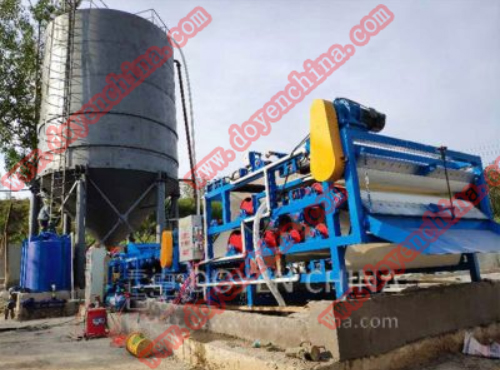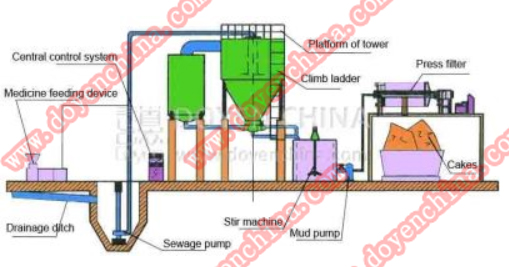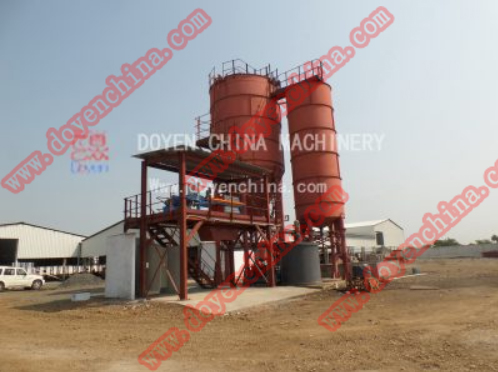

Tel:
+86-757-8633-0278
Email:doyen@doyenchina.com
Fax:+86-757-86287390
Address:Room 201, Building No. 24, Yicui Rose Garden, No. 2, Jihua 7 Road, Chancheng District, Foshan City, Guangdong Province, China 528000.
The treatment depth of the sludge dehydrator used in wastewater treatment is different, and the amount of sludge is also different. Analysis with you
1、Grid slag:
Because of the differe nt raw materials and processes of textile printing and dyeing, the pretreatment grids of waste water in cotton spinning, wool spinning, silk dyeing and finishing and linen spinning and dyeing industries are different.

Cotton spinning printing and dyeing industry: The pretreatment grid slag mainly comes from the fine fibers, yarns, rags, etc. discharged from the processes of natural cellulose removal, yarn finishing, and grey cloth treatment. In addition, for denim washing in the denim clothing industry, due to the use of pumice stone, the discharged wastewater contains a large amount of fine sand, which accounts for a large amount of sand (about 50 to 70% of the sludge volume of the entire washing and bleaching wastewater treatment plant) and is easy to deposit and compact. It needs to be cleaned up in time, otherwise the whole wastewater treatment system may have sedimentation phenomenon, which will affect the sewage treatment effect. Wool textile printing and dyeing industry: Most of the raw materials used in the wool textile industry are animal wool fibers, mainly wool. The waste water discharged from wool selection and scouring processes contains impurities such as dust on wool, plant thorns, and fine hair. When a five-tank combined scouring machine is used, the solid impurities mainly come from the top tank. Silk dyeing and finishing industry: chemical fiber simulation silk processing wastewater contains impurities such as fine fibers, and the cocoon peeling and cocoon cooking processes in the natural silk production process will discharge wastewater containing waste cocoons, fine silk and other impurities. Hemp spinning printing and dyeing industry: the main impurities in hemp spinning printing and dyeing wastewater are fine hemp fibers.
2、Physical and chemical sludge
3、The physical and chemical sludge of printing and dyeing wastewater comes from the coagulation sedimentation or coagulation air flotation treatment unit of the wastewater. The source of the wastewater and the type and dosage of the added coagulant and flocculant are different. The composition of the sludge and the amount of sludge are all It is different, mainly for the combination of slurry, dye and coagulation and flocculation agent.
4、Biochemical sludge
5、The biochemical sludge of printing and dyeing wastewater comes from the activated sludge process unit, including anaerobic (hydrolytic acidification), contact oxidation, biological filter and other residual sludge discharged. The content of organic matter in biochemical sludge is relatively high, but it is generally less than that in municipal sewage (generally less than 50%).

6、Physical and chemical sludge and biochemical sludge are generally not treated separately, and the concentration-dehydration process can be uniformly used. Intermittent or continuous dewatering equipment is determined according to the amount of sludge produced. The intermittent dehydrator is mainly a plate-and-frame box filter press, while the continuous dehydrator is a belt filter press. It is recommended to use continuous dewatering equipment for wastewater treatment capacity above 1000m3/d; treatment capacity is 5000m3/d, when there is a physical and chemical treatment process, a belt filter press with a bandwidth of 2 meters can meet the requirements. Sludge drying field can also be used when the amount of sludge is small. When the printing and dyeing wastewater is mixed with a large amount of domestic sewage, on the one hand, the biodegradability of the wastewater can be improved, and on the other hand, the issue of phosphorus and nitrogen removal should be considered according to the water area of the discharge. Since the sludge thickening tank is set up, the sludge will stay for a longer time and easily lead to the release of phosphorus. For this reason, a thickening and filtering integrated machine can be used.
In my country, it is a good choice for printing and dyeing companies to transport printing and dyeing sludge to municipal waste incineration plants. Sanitary landfilling of mud cakes and pre-treatment sedimentation is also another method of sludge disposal. The landfill site has requirements for the soil quality of the overburden. One is to meet the requirements of sanitary landfill, and the other is to take into account the final use of landfilled garbage and restore the use value of the land.

Doyen specializes in providing belt press equipment for the Southeast Asian market. Welcome to visit our workshop and formulate a more scientific plan based on the actual situation of your company. Welcome to visit joyce@doyenchina.com or visit https://www.doyenchina.com.
Dec-23-2020
admin

 +86-757-8633-0278
+86-757-8633-0278 doyen@doyenchina.com
doyen@doyenchina.com Sitemap
Sitemap